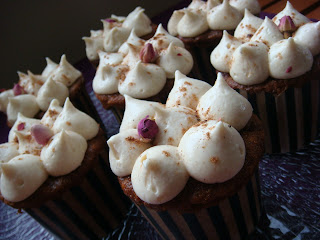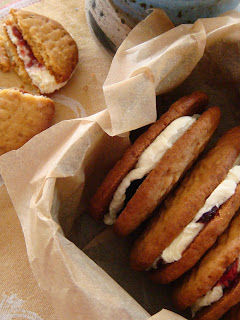As a child I remember visiting the local cake shop and gazing at the array of sweet treats. Cream buns, tea cakes, meringue snowmen, custard tarts, cream horns and more standing shoulder to shoulder in the glass cabinet, just at the right height for a hungry child to drool over.
On the occasions when I was allowed to choose, my favourite was always the little cream filled tarts made to look like an upside down mushroom. A crisp, sweet pastry case with a dollop of plum jam in the bottom, covered with vanilla mock cream, dusted with cocoa and nutmeg and a little pastry stalk. Just a magic mouthful of sweetness to brighten up the day. So much better than the neenish and pineapple tarts with their tooth achingly sweet icing.
While neenish and pineapple tarts seem to have lasted the distance sadly the little pastry mushroom has not. On a rare occasion I succumb to a neenish tart but they are nearly always a disappointment. Lovely in their own way they never quite match up to that childhood memory of a sweet little mushroom tart. So with damson jam and left over sweet paste to be used it's time to take a trip down memory lane and see if these childhood favourites are the same as I remember.
A bit of research unearthed a few online discussions about 'remember those little...' and a Country Women's Association document outlining how to present them at a show but none of the recipes listed were quite what I remembered. That's the problem with childhood food memories. They are born of unjaded taste buds still reeling with amazement at all the incredible flavours in the world and enhanced by the innate childlike ability to give the everyday a touch of magic. They are further complicated by the adult memory which seems to see the past through a rosier lense. Were these the mushrooms around which faeries danced? Perhaps.
Once thawed the pastry was rolled to about 3mm thick and cut into rounds with a 5 cm scone cutter. The pastry bases were pressed into a dished patty pan tin. Once pricked with a fork they were filled with pastry beads and cooked at 170C for about 6 minutes, the beads removed and the bases returned to the oven for another 5 minutes until golden brown. The remaining pastry was rolled into a thin sausage shape, cut into 3 cm lengths and baked on a biscuit tray in the oven to make the mushroom stalks.
After cooling a half teaspoon of plum jam was placed into the pastry bases and then covered with mock cream. The tops were levelled with a knife and dusted with cocoa, a little nutmeg and a pastry stalk was pressed gently into the middle of each one.
The mock cream recipe used here was one in which you make a sugar syrup and beat it into the butter. I like this one by Robyn Alderton on ABC Central West NSW radio which can be found here on the ABC website. There are however lots of mock cream recipes and if you want to try these I suggest you use one with which you're familiar or one that appeals to your taste. Some use gelatin which improves the stability of the mock cream but I know that these won't last long round here so I didn't include it.
So were these mushroom mouthfuls as I remembered them? The tartness of the plum jam offset the sweetness of the mock cream in a perfect combination. Rich and sweet they were also dainty and small, my idea of the perfect sweet treat. One (or maybe two) mouthfuls to satisfy the sweet tooth without too much damage to the derriere. If I close my eyes I can almost feel my nose pressed against the cake shop window. Move over macarons.




















